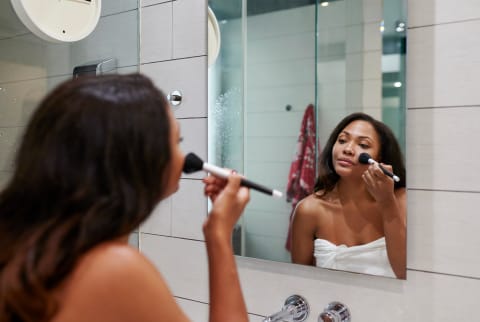Advertisement
Makeup Therapy: How The Beauty Trend Brightens Your Eyes (& Your Mood)


I know I'm not the only one to fall victim to makeup tutorial mania. Beauty hauls are nothing new, but I'd argue our "get ready with me" culture has officially hit the fever pitch, and after consuming clip after clip, I noticed those chatty videos have something in common: They beautifully merge makeup and mental health. The hashtag #makeuptherapy even has 146 million views and counting.
Below, I tapped psychologists about the "makeup therapy" phenomenon and why it provides feelings of comfort, not only for the users but also for the folks (like myself) endlessly scrolling through.
The power of makeup routines
"Makeup therapy" is unique in that it provides a moment of solace not only for the creator but for the viewers themselves. But let's start with the creators: There's a very good reason beauty lovers turn to a striking face beat when they're feeling down—makeup just has the ability to spark joy.
In fact, research has shown that makeup therapy was correlated with significantly higher happiness scores1 in participants with dementia. Of course, we're talking about two very distinct populations here—the average population on TikTok versus older adults with dementia—but it's clear that makeup has the ability to lift your spirits.
"It's not just the makeup itself, but it's also the colors that reflect our inner moods," says neuropsychologist Sanam Hafeez, Psy.D. "It's pretty powerful to be able to wear something that reflects the way we're feeling on the inside."
A makeup routine also serves as a ritual, and research has shown that stress can result in ritualized behavior2, such as repetitive movements (swipe, blend, set, and repeat). It gives people some semblance of control, a sense of agency in an otherwise uncertain world. Plus, the steady routine requires their full focus, thus taking their attention away from what's making them feel anxious.
The power of posting makeup routines
So applying makeup can make you feel happier. Why display it for the world to see? Well, according to clinical psychologist Chloe Carmichael, Ph.D., sharing grooming behaviors usually signifies trust in evolutionary psychology—a "you show me yours, and I'll show you mine" mentality that generates cooperation and intimacy. "We can learn from each other, as opposed to feeling like we're competing for mates," she says.
Plus, makeup is something you usually interact with in the privacy of your own home. "Typically, it's considered a little uncouth to sit on the bus and put on makeup," Carmichael adds. "So there's something about it culturally that's a little bit private and therefore intimate."
I likely don't need to remind you that we're amid a loneliness epidemic, and these intimate experiences can help fill a void for some people. It doesn't have the same effect as IRL relationships, mind you, but at least it's something for those who have trouble connecting.
The power of watching makeup routines
But these makeup routines aren't even focused on the products themselves! Sure, a user might swipe on a sparkly shadow, but rather than explaining the formula or the best application methods, they're sharing unrelated personal stories. What makes them so mesmerizing?
According to Hafeez, it's a classic case of parallel visual storytelling, where your brain is involved in two sensory activities at the same time: the listening and the watching. Carmichael agrees: "If they were showing you the makeup video in silence, you might get bored. If they were telling you about their day by itself, you might get bored," she says. "Pairing them together gives your brain a little bit more variety."
Doubling up activities also creates space for a bit more vulnerability. "It's a little bit of a red herring," Hafeez says. "In distracting you, they're actually sharing a lot more that may feel too intense. It works because the public also realizes that they're hearing something vulnerable, but it doesn't make it uncomfortable for them either."
As you watch someone coat on mascara, perhaps they also share their anxieties or fears. "[They] suddenly feel like they can blurt out something because there's a context of a different behavior in a different activity," Carmichael adds.
After scrolling through my For You Page with this context in mind, I was floored by how many users do, in fact, use makeup to reveal something below the surface. "I'm literally using makeup as therapy today," says content creator Mina Hasan in a video.
She shares that her dermatologist told her that her hair loss was "concerning," as she taps in her concealer with a beauty blender. "I just hate uncertainty and not being in control of a situation," she reveals while lining her lips with precision.
Just last week, beauty journalist and esthetician Rio Viera-Newton posted a video of her makeup routine while discussing her treatment and recovery process from an eating disorder. She kicks off the routine with: "Get ready with me while I overshare."
Both Hasan and Viera-Newton are aware that they're sharing something private (it's not like they're blurting out personal information on the fly), but the makeup distraction might make the delivery just a touch easier—for them and the viewer.
The takeaway
If this TikTok trend teaches us one thing, it's that applying your favorite color cosmetics—and posting your routine for the world to see—can be a form of art therapy.
After all, there's a reason professionals are called makeup artists; makeup can be transformative, and it's all about self-expression. "It's a form of self-reflection," adds Carmichael. "But I think it's also a chance to reinvent ourselves again."